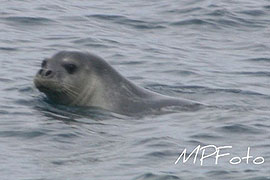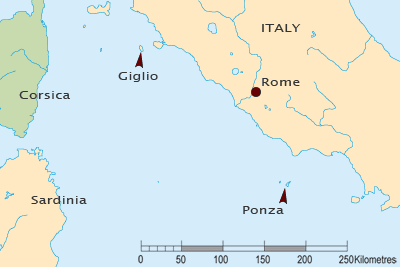

 |
||
 |
||
Vol. 12 (2): November 2009 |
||
Monk seal sightings in Italy move
|
 |
|
|
|
The first sighting was reported by a tourist who was visiting the island of Giglio on Sunday June 6th, 2009. The sighting occurred at 11 a.m. close to the rocky outcrops just outside the port of Giglio Campese. Startled by the cries of onlookers exclaiming about the presence of a seal a few metres away from the rocks, the sighter, who is also an amateur photographer, grabbed his camera and quickly approached the location where he was not only able to take several photographs of the seal but also observe it during its surfacing bouts within a time frame lasting 35 minutes. The seal was observed swimming on the surface, approximately 10 metres from the coast. Its alternated surfacing bouts lasted between 2 to 20 seconds in between which it dove and disappeared temporarily from sight for 5-20 minutes. Every time it surfaced it tended to do so slightly farther away from the sighter’s position. The sighter carefully described the seal’s prominent nostrils and round head, eyes and vibrissae. He estimated the seal’s body length as being at least 2 metres, and described the colouring as being dark grey on the dorsum and increasingly darker towards the tail area, with lighter spots especially in the anterior part of the dorsum. The sighter also declared that the seal’s movements in the water were slow and calm, which would lead one to assume that the seal did not feel threatened or nervous even though it was often observed looking in the direction of the rocks towards the bystanders when it surfaced after a dive bout. Analysis of the photos confirms the size class category of a subadult-adult sized individual.

The second sighting was recorded on Saturday August 29th at 11.30 a.m. close to a rocky islet to the southeast of the island of Ponza. The sighter, an amateur free diver, was on a spearfishing dive and was inspecting a submerged rocky reef lying at 15 metres depth. One side of the submerged reef edge ended with a small rocky overhang situated on a sandy bottom and nearby, a rich Posidonia meadow. The diver noticed a dark grey mass partially jutting out from underneath the rock ledge and, driven by curiosity, approached it to identify the species, assuming it may have been a large fish. He recounted that as he approached the site the animal was so still that his immediate thought was that it may have been dead, possibly due to the various pieces of lost fishing gear he had observed attached to the rocky outcrops in that area. At less than 2 metres distance from the animal, and having reached a depth of approximately 15 metres, he saw that the dark gray mass was the posterior part of a spindle-shaped body at the end of which protruded two large flippers. The sighter describes the flippers as having longer lobes on their outermost sides compared to the inner and explains that he thought they were seal flippers given that they had a “webbed-like appearance like that seen in the wings of bats” and he could see “the layer of skin uniting one digit to another”. It appeared to him that the animal was lying partially on its side with the remaining part of its upper body resting on the sandy bottom under the shallow rocky overhang. At that point he noticed that the flippers swayed very gently with a slowly rubbing motion which brought them one against the other and so he concluded that the animal could not have been dead. He quickly resurfaced to call his other two dive companions who were on the boat, but tried to keep an eye on the animal so as not to lose sight of it. Within less than two minutes he and his dive companions observed the seal exiting the rocky overhang and swimming towards midwater at approximately 5-10 metres distance from them. Their impression was that the seal was aware of their presence and looked towards them and then slowly swam away in the direction of the nearby rocky islet. The duration of the entire sighting was estimated as lasting less than 3 minutes. The sighters clearly described the physical characteristics of the head (round ocular orbits, rotund head, pronounced snout), the spindle-shaped body and flipper position. The seal was estimated as being quite large, comparable in length to an adult man, with a dark grey head and posterior part of the body and an overall lighter coloured abdomen. The sighters also claimed that the seal may have had some lighter coloured markings on the dorsal part of the body though the exact location and extent of these was difficult to recall in great detail given the reduced precision of vision underwater and the limited duration of the sighting.
Following these sighting events immediate contact was made by ISPRA with the local Coast Guard offices to request that they exercise particular attention to collecting any other sighting information reported from local fishermen or tourists. Within the framework of the Coast Guard’s fishery monitoring activities, specific attention was also paid by the personnel to collecting information on possible specific damage to fishing gear which might be attributable to seals frequenting the area.
Given the low number of seal sightings in Italy it appears likely that the seal sighted and photographed in Giglio island at the beginning of June may be the same seal sighted in Ponza at the end of August 2009. The description of the pelage colouring and size estimate reported by the observers of each sighting would also tend to confirm this. If true, it would mean that the seal’s movements from the first sighting location to the second would have entailed a journey of approximately 140 miles within 3 months, a not uncommon occurrence given accounts of observations of photoidentified adult sized individuals in other locations, such as Greece. What is puzzling is from where this particular seal may have originated. The nearest Italian monk seal sighting locations are those found in Sardinia, which lies at 100 miles distance from Giglio island. If indeed monk seals observed in peripheral Italian locations originate from the nearby north African coasts, the sightings observed in summer 2009 in Italy indicate that a monk seal’s dispersion capacity from its original location may rank on the order of at least three hundred miles.
Copyright © 2009 Giulia Mo, The Monachus Guardian. All Rights Reserved |